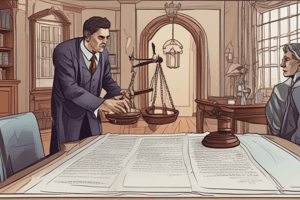Podcast
Questions and Answers
What is the role of coercion in contract law?
What is the role of coercion in contract law?
Coercion operates on the mind of the victim by forcing him/her to choose between entering the contract or suffering harm.
In the context of coercion, what must the reasonableness of fear entail?
In the context of coercion, what must the reasonableness of fear entail?
The threat must be sufficiently grave to affect the mind of a reasonably steadfast person.
What impact does unreasonable fear have on the acceptance of coercion in a contract?
What impact does unreasonable fear have on the acceptance of coercion in a contract?
The more unreasonable the fear, the greater will be the reluctance of the court to accept that it actually induced the contract.
In the case of Paragon Business Forms (Pty) Ltd v Du Preez, what was the court's opinion regarding the alleged fear of the respondent?
In the case of Paragon Business Forms (Pty) Ltd v Du Preez, what was the court's opinion regarding the alleged fear of the respondent?
What is the object of the threat in the context of duress?
What is the object of the threat in the context of duress?
Why is proof of protest sometimes required in cases of duress?
Why is proof of protest sometimes required in cases of duress?
Is silence generally considered indicative of free consent in cases of duress?
Is silence generally considered indicative of free consent in cases of duress?
What condition must the threat meet in terms of imminence to be considered under duress?
What condition must the threat meet in terms of imminence to be considered under duress?
What is intentional (fraudulent) misrepresentation?
What is intentional (fraudulent) misrepresentation?
How does negligent misrepresentation differ from intentional misrepresentation?
How does negligent misrepresentation differ from intentional misrepresentation?
What is innocent misrepresentation?
What is innocent misrepresentation?
In misrepresentation, what renders a contract void?
In misrepresentation, what renders a contract void?
What remedy attempts to restore both parties to the position they were in prior to entering into a contract?
What remedy attempts to restore both parties to the position they were in prior to entering into a contract?
What kind of misrepresentation renders a contract voidable?
What kind of misrepresentation renders a contract voidable?
What are the remedies available in case of negligent misrepresentation?
What are the remedies available in case of negligent misrepresentation?
What is the onus of the party alleging undue influence?
What is the onus of the party alleging undue influence?
When can the innocent party bound by the terms of a contract?
When can the innocent party bound by the terms of a contract?
Give an example of intentional misrepresentation.
Give an example of intentional misrepresentation.
What happens if the innocent party elects to rescind the contract?
What happens if the innocent party elects to rescind the contract?
What distinguishes innocent misrepresentation from the other types of misrepresentation?
What distinguishes innocent misrepresentation from the other types of misrepresentation?
What duty arises on both parties if a contract is rescinded?
What duty arises on both parties if a contract is rescinded?
Can a contract be enforced in the case of innocent misrepresentation?
Can a contract be enforced in the case of innocent misrepresentation?
What is the key factor in misrepresentation inducing a party to contract?
What is the key factor in misrepresentation inducing a party to contract?
What type of remedy is available in cases of undue influence?
What type of remedy is available in cases of undue influence?
Who has the discretion to decide whether to uphold or rescind a contract under undue influence?
Who has the discretion to decide whether to uphold or rescind a contract under undue influence?
What are the requirements for a misrepresentation to be considered valid?
What are the requirements for a misrepresentation to be considered valid?
What is active concealment in the context of misrepresentation?
What is active concealment in the context of misrepresentation?
What is required for misrepresentation to induce a contract?
What is required for misrepresentation to induce a contract?
In what scenario would there be no rescission even with misrepresentation?
In what scenario would there be no rescission even with misrepresentation?
Explain designed concealment (non-disclosure) in the context of misrepresentation.
Explain designed concealment (non-disclosure) in the context of misrepresentation.
What was the case of Dibley v Furter about?
What was the case of Dibley v Furter about?
What is the difference between causal misrepresentation and incidental misrepresentation?
What is the difference between causal misrepresentation and incidental misrepresentation?
What are the three types of misrepresentation mentioned?
What are the three types of misrepresentation mentioned?
What action did F take regarding the graveyard in the case of Dibley v Furter?
What action did F take regarding the graveyard in the case of Dibley v Furter?
What must be the intention behind a misrepresentation for it to be significant in inducing a contract?
What must be the intention behind a misrepresentation for it to be significant in inducing a contract?
What was the outcome of the case Dibley v Furter regarding the non-disclosure of the graveyard?
What was the outcome of the case Dibley v Furter regarding the non-disclosure of the graveyard?
How does causal misrepresentation differ from incidental misrepresentation in terms of contract formation?
How does causal misrepresentation differ from incidental misrepresentation in terms of contract formation?
Why was F held liable in the case Dibley v Furter for not disclosing the graveyard?
Why was F held liable in the case Dibley v Furter for not disclosing the graveyard?
Provide an example case that highlights the importance of misrepresentation in contract formation.
Provide an example case that highlights the importance of misrepresentation in contract formation.
Flashcards are hidden until you start studying
Study Notes
Types of Misrepresentation
- Intentional (fraudulent) misrepresentation: made with the intention of persuading the other party to conclude the contract, renders the contract void
- Negligent misrepresentation: made negligently, renders the contract voidable, remedies include setting aside the contract, enforcing the contract, and claiming damages
- Innocent misrepresentation: made innocently, renders the contract voidable, remedies include setting aside the contract and enforcing the contract
Coercion and Duress
- Coercion operates on the mind of the victim, forcing them to choose between entering the contract or suffering harm
- Reasonableness of fear: the threat must be sufficiently grave to affect the mind of a reasonably steadfast person
- Object of the threat: the threat must be directed at the life, bodily integrity, or property, or immediate family
- Imminence of harm: the threat must be imminent or inevitable
Undue Influence
- Occurs when one person exploits their influence over another to persuade them to agree to a transaction that is detrimental to them
- Remedy: restitutio in integrum, which attempts to restore both parties to their original position before entering into the contract
Misrepresentation Requirements
- The misrepresentation must be a false statement of fact
- The misrepresentation must be material
- The misrepresentation must be made by a contracting party or someone for whom they assume responsibility
- The misrepresentation must be made with the intention of persuading the other party to conclude the contract
- The misrepresentation must be believed by the other party and induce them to enter into the contract
Types of Misrepresentation Statements
- Express statement, verbal statement, or implied from conduct
- Active concealment: failure to correct a false impression
- Designed concealment (non-disclosure): intentional concealment of information that the person is under a duty to disclose
Studying That Suits You
Use AI to generate personalized quizzes and flashcards to suit your learning preferences.




